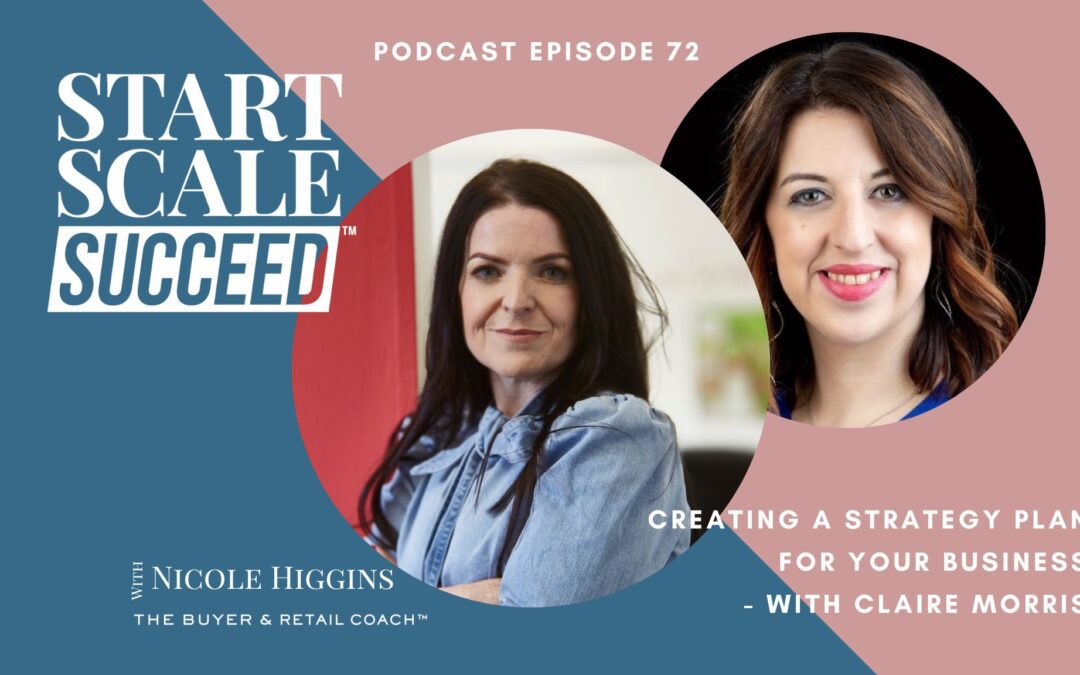How do you create a strategy plan for your business? It’s a crucial step whether you are starting or scaling your business, but something that can make many people feel daunted, overwhelmed and with no idea of where to start.
I asked Claire Morris, the founder of Retail With Clarity, to join me on my podcast Start, Scale, Succeed to share her top tips. Claire is a numbers expert and specializes in working with small retailers to improve profit, stockholding & cash flow.
The steps below take you through everything you need to know for planning your business and budget for the upcoming year so that you feel confident and informed about your business.
Creating A Strategy Plan For Your Business
When it comes to strategizing for the year, businesses with at least a year of trading experience can follow a few key steps.
1 Conduct an In-Depth Review
It all starts with taking a good look back. This review can be done at any time, but the New Year is often an ideal moment. However, if you have a seasonal business, it’s recommended to do this more frequently, perhaps every three to six months, with a minimum of once a year.
Analyze sales, costs, inventory, and other key performance indicators over the past 12 months:
- Sales revenue overall and by product category, channel, season etc.
- Profit margins overall and by product, supplier, manufacturing cost
- Inventory costs, units on hand, sell-through rates
- Best selling items vs poor performers
Sales patterns can be deceiving. A high-selling product line may have actually sold through only 30%, indicating a potential overstock issue. Conversely, a low-volume product that sold out quickly presents an opportunity to restock and profitably sell more.
Look for trends, strengths, weak spots, and opportunities.
For example:
The data may show size medium t-shirts had high sales but excess leftover inventory, indicating a future stock planning issue.
A specific candle fragrance may have sold out quickly, pointing to an opportunity for additional versions.
A retailer selling home goods may find category A delivered high volumes but low margins while category B had fewer sales but better profitability per item. This indicates pricing adjustments may be needed.
These valuable insights will shape your strategy plan.
2: Perform a SWOT Analysis
Performing a SWOT on your own business is powerful. It will allow you to identify your business’ current Strengths, Weaknesses, Opportunities and Threats. Consider all internal factors like staff capabilities as well as external forces like regulatory changes.
 What is a SWOT Analysis?
What is a SWOT Analysis?
A SWOT assesses your business’ Strengths, Weaknesses, Opportunities, and Threats:
Strengths – Core competencies, competitive advantages, human capital, brand equity
Weaknesses – Gaps in skills, inefficient processes, compliance issues, negative brand perception
Opportunities – Favorable industry trends, new technologies, market demand, partnerships
Threats – Regulatory changes, competitor innovations, economic conditions, changing consumer preferences
Use insights from SWOT to build on strengths, address weak areas, pursue opportunities and counter threats as you shape strategy. Some factors are within your control, like having a strong sales team as a strength. However, external factors like rising minimum wages or cost of living can make it costly to maintain your current staff.
Identify which categories you will grow, maintain, or exit. If you’re declining or exiting, seek new opportunities to replace and surpass those sales targets. When a core product line is saturated among existing customers without updates or new customer acquisition, it becomes unnecessary in its current form. This can result in excess stock or the downfall of a previously successful product. For example, this is a particular challenge in the toy sector, as trends can come and go swiftly.
3 Look at your numbers
Understanding the significance of numbers is crucial, as many people fear them. By gaining a solid grasp and comprehension of your numbers, you can make more confident decisions for the future.
To start, leverage data to establish specific goals for next year’s sales and profits, allowing the numbers to guide you.
Break down your top-level goals into smaller milestones, focusing on product categories, channels, markets, and other relevant factors. This breakdown facilitates effective tracking of progress.
For instance, let’s say you want to boost your turnover from 50,000 to 60,000. In this case, focusing on Wholesale could be a viable option. By aiming to secure 10 new accounts, you simplify the process and potentially generate the additional 10,000 needed to reach your target.
Ensure that your activities align with the findings from your SWOT analysis. For instance, if the analysis identifies an opportunity in a new market, set a sales goal for that market and establish tactical objectives to help you accomplish it.
However, it’s important to remember that setting goals alone is insufficient. Taking action is key. Prioritize setting your sales target – the number you aim to achieve in the coming year.
Don’t forget to determine your desired profit in relation to the sales target. Conduct a thorough examination of your business costs, document them, and confront the numbers. Initially, this may seem daunting, but keep in mind that you have control over them. Analyze your sales and projected costs to ascertain the resulting profit. If your goal is to enhance profitability, explore opportunities to reduce costs or raise prices to achieve that goal.
4: Define Your Marketing Budget
Review marketing performance and ROI over the past year. This is crucial, it is easy to spend a bit on marketing here, and a bit there, and not analyze how this spend is performing for you.
Look at:
- ROI of campaigns, promos, ads – parse data on conversions, redemption rates, sales impact
- Engagement metrics for content types – website visits, email CTRs, social following
Then optimize your spending and channel mix accordingly. Set an overall budget benchmark – and avoid ad hoc efforts.
Don’t forget to map out an editorial calendar to schedule social media, email, blog content etc.
5 Manage Your Promotions & Sales
Blanket discounting is a no no it’s the worst cycle to get stuck in. It may be a footfall driver, and drive some sales, but it destroys your profit.
To boost your business, focus on strategies to drive basket size. Get creative to encourage customers to add more items to their baskets and spend more overall. Don’t forget about those products that aren’t flying off the shelves as quickly as you’d like. Offer deals like “spend a certain amount and save X” or run special promotions to tackle specific problem products. If it’s a whole category that needs a boost, consider applying promotions across the board. And when you’re phasing out a product, it’s the perfect time to offer discounts and clear them out.
Try a staggered discount strategy by starting with a modest discount, say 20%. This will help drive up sales volume and allow you to gauge if it’s clearing the stock within your desired timeframe. Later on, you can reassess and consider deeper discounts if necessary. Remember, starting with a smaller discount can often be more profitable in the long run.
Keep in mind that there are guidelines in place for newly introduced products, which mandate selling them at a specific price for 28 days before offering any discounts.
Should I buy stock in for promotions like Black Friday?
Avoid buying in stock just for one-off events such as Black Friday. Instead, leverage your existing stock and capitalize on the consumer mindset of making purchases during that period. Use this time to increase your visibility and consider implementing some price adjustments on slower-selling items.
The one time you may want to buy in stock for one-off events is to take advantage of specific brand opportunities for things like Barbie & Disney movies. Make sure you have an exit plan, as these brands will usually have a flash point, and then sales will drop off quickly.
What profit margin should I be aiming for?
The profit target varies depending on the industry you’re in. For instance, in the electrical products industry, profit margins tend to be lower, ranging from around 10% to 20% for high-ticket items. To balance this, businesses often focus on higher-margin accessories, which can reach margins of up to 80%. Overall, a typical mix of profit margins in this industry falls somewhere around 30% to 40%. On the other hand, clothing retailers can aim for profit margins as high as 70% to 80%, even after factoring in any discounts, with margins of 50% to 60% being common.
How do I set sales targets when I am just starting out?
If you’re new to trading and lack historical data, setting sales targets requires estimation. Start by estimating the number of customers you expect, their purchasing habits, and the average selling price of your products. Multiply these factors to calculate an overall sales figure. It’s important to challenge your estimations by setting a realistic target and a more ambitious stretch goal. Make sure you have sufficient inventory to meet these targets.
Moreover, consider your operating expenses and ensure that your projected sales can cover them. Take into account all outgoing expenses and factor in a portion for your own compensation. Strive to achieve a break-even point where your sales cover your costs and allow you to pay yourself.
In Conclusion
Continuously track your progress against your strategy plan to assess how well you are delivering on it. If you have products that are exceeding expectations, focus on restocking and seizing the opportunity to capitalize on their success. On the other hand, for items that are moving slower than desired, it’s crucial to make decisions that mitigate potential profit impacts later in the year. By comparing your current performance to the established plan, you can promptly identify areas that require attention and make necessary changes accordingly.
Thank you so much Claire. You can listen to the full podcast here.
I hope that this post helps you to continue on your journey to success and if you need any extra support then check out my free resources on my website, follow me on Instagram, subscribe to my monthly newsletter or get in touch at nicole@thebuyerandretailcoach.com
https://thebuyerandretailcoachltd.as.me/discoverycall Book a free discovery call to see how we can work together and how I can help you with your business or idea
https://thebuyerandretailcoachltd.as.me/powerhour Book a power hour with and get the clarity of what your next steps need to be and your questions answered.
The Buyer and Retail Coach is a global retail expert with over 18 years experience working in the industry as a buyer and head of buying for companies such as Primark, M&S, and George at Asda, developing and sourcing a broad range of products from Lingerie to Health & Beauty and driving strategies and innovation.
Having worked for the big blue chips, Nicole Higgins now brings that expertise and experience to entrepreneurs and SME’s to help you make your product ideas a reality, scale your business, and increase your bottom line and profits.


